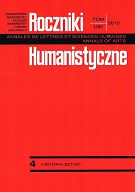"Poczucie malarskie graniczy tutaj z wizyjnością; kształt tonami znaczony przypomina senne obrazy". Le peintre-graveur oczami Franciszka Siedleckiego
“The Painter’s Feeling is on the Verge of Visuality; the Shape Marked With Tones Creates Dreamy Imagery.”
Author(s): Jolanta CzerzniewskaSubject(s): Cultural history
Published by: Towarzystwo Naukowe KUL & Katolicki Uniwersytet Lubelski Jana Pawła II
Keywords: Franciszek Siedlecki; Feliks Jabłczynski; etching; acquaforte; Feliks Jabłczyński; grafika; akwaforta
Summary/Abstract: In 1927, Franciszek Siedlecki published his work entitled Grafika polska w oewietle krytyki zagranicznej [Polish etching graphics in the light of foreign criticism]. In his essay, he proposed a metaphorical conception of etching graphics, defined as a philosophical path towards enlightenment. Siedlecki considered Rembrandt to be the ideal embodiment of his philosophy. Siedlecki was one of contributors to the collective volume published in 1938, entitled Feliks Jabłczynski (1865-1928). Monografia zbiorowa [Feliks Jabłczynski (1865-1928). A collective monograph]. In his essay there (Grafika Feliksa Jabłczynskiego (1865-1928)[Etching graphics by Feliks Jabłczynski (1865-1928)]), he presented his model of a prototypical master of acquaforte etching, drawing mostly upon Rembrandt’s achievements. This paper analyses the above-mentioned collective volume understood as a treatise on the inter-war Polish art and its main focus on polemics with the modernist myths concerning language, art and the artist. Siedlecki’s essay in thie collection has a two-fold role to play. Firstly, it presents a metaphor of an ideal work of art. Secondly, it serves as a consolidating factor for all the parts of the publication. His text is an instrument for a philosophy of the language of art. Siedlecki’s discourse focuses around Jabłczynski, his artistic workshop and the invention of monotyping – in other words it focuses on the artist’s creation space and creation philosophy. Siedlecki uses an elevated and almost a monumental style. He disguises Jabłczynski as a peintre-graveur, an ancient master, alchemist or a shaman. This disguise symbolizes the need of the 20th-century art to return to the very beginning and the ultimate source of all creation in its search of inspiration, philosophy and imaginativeness. Siedlecki refutes the reproductive function of etching, as subservient to painting. In his eyes, etching is closely related to drawing. An etching work relies on an ideal, a sign and a symbol. It must have its poetic, fairy-tale, ludic and musical aspects. Etching is an element of spiritual energy, manifesting itself in attempts to synthesize all branches of human creation. The presence of the graphic element in the etching helps materialize spiritual aspects. The contemporary artistic workshop is a testing range with its vital function for shaping human personality and character. The artist is like Prometheus in his “offering” of artistic work. Doomed to eternal failure, Jabłczynski – as seen by Siedlecki – is an allegoric figure of a Sisyphus: the artist and his art are permeated by the tragedy of human existence. Thus, Siedlecki’s programme for contemporary art was to guarantee freedom, paid for by pain and by an endless struggle for reaching the ideal. On the other hand, he saw art as being widely publically received and acclaimed. He strongly believes in a social revival through an educational power of the artistic workshop.
Journal: Roczniki Humanistyczne
- Issue Year: 58/2010
- Issue No: 04
- Page Range: 207-248
- Page Count: 42
- Language: Polish

